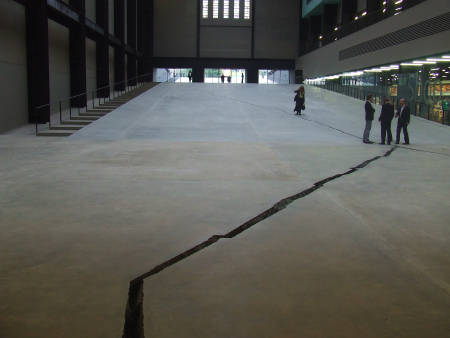虽然把自己的文章从网站上转来转去显得多此一举,不过有些文章似乎同时适合发在不同网站上,比如这篇 Shibboleth,原文发在 Play With Words。
Shibboleth 是哥伦比亚艺术家 Doris Salcedo 在伦敦 Tate Modern 的“轮机房大厅”(Turbine Hall)的作品。Turbine Hall 中的作品,可以任凭作者想像,限制只是这个原电站轮机房内部巨大的空间,一年换一次。Shibboleth 是第7届作品。
Shibboleth (Oxford English Dictionary):
a word used as a test for detecting people from another district or country by their pronunciation; a word or a sound very difficult for foreigners to pronounce correctly.
Shibboleth 的来源是:
The Old Testament relates that the Ephraimites were trying to cross the river Jordan when they were caught by their sworn enemies the Gileadites, who forced them all to say the word “shibboleth”. Since the unfortunate Ephraimites’ dialect did not include the sound “sh”, this allowed the Gileadites to identify and slaughter large numbers of Ephraimites.

Shibboleth 是件真正利用 Turbine Hall 空间的作品:大厅混凝土地面上的一条裂缝。大厅入口处的垃圾桶地下开始,是地面上的一条细小的裂缝,细缝向厅内延伸,越变越大,在某处分成两支,最粗之处成人可以伸入手臂--但深不能见底。
这件作品,是如何做出来的?难道真是在 Tate Modern 地面上凿出一条裂缝?艺术馆表示绝不会透露内幕。不过上周《卫报》上有篇非常精彩的介绍文章,而且最后还会透露这件作品的制作秘密。



[…] 上个周末去伦敦时,我去了 Tate Morden。许多人都象我们一样,从入口循着地上的细缝,一路走向“轮机房大厅”的另一头,再回头仔细研究这条裂缝,试图弄明白它是从哪儿来的。大人小孩都在裂缝两遍蹦来蹦去,不少人把脚伸进去,有的还趴在地上拍照研究,大厅里迷漫着兴奋、激动、好奇、诧异、迷惑。一件艺术作品,能让普通观众从头到尾仔细研究,产生多种奇怪的情绪,至少这点上,Doris Salcedo 的这件作品是成功了。 […]
[…] 轮机房大厅展的特色之一是观众与展品的交流互动,展品与观众置身于同一巨大空间内,互动不仅是难免的,而且是备受鼓励的,前作包括地板上的一条裂缝 Shibboleth(现在去还可以看到修补的痕迹)、一个巨大的黑箱、三个螺旋滑梯等,都有这一特色。Tate Modern 鼓励参观者踩踏(穿鞋的或光脚的)、拣拾,但参观者能不能拣一颗带回家? Tate Modern官方的声明是很客气的“我们鼓励参观者不要把葵花籽带走。”但是据《卫报》报道,艾未未本人的态度却比较模棱两可:“对于博物馆来说,展品是一个整体,但如果我是参观者的话,我就会想拿一个走。” […]